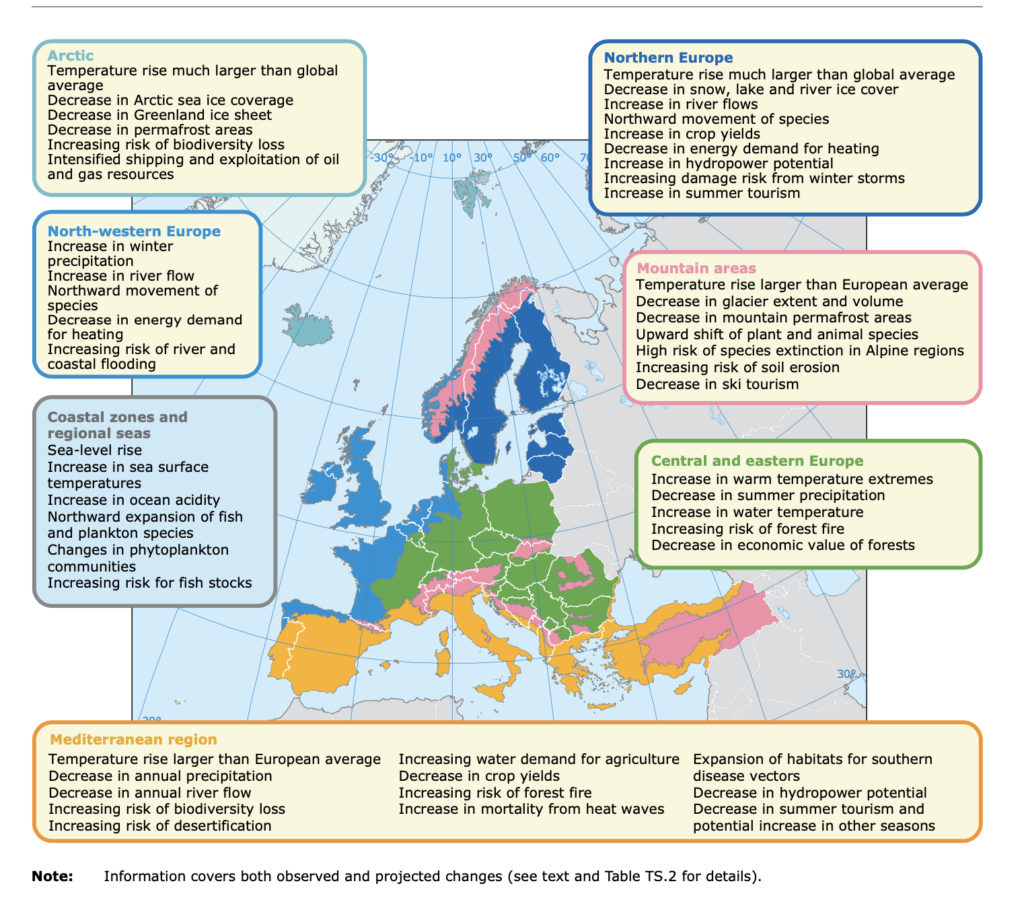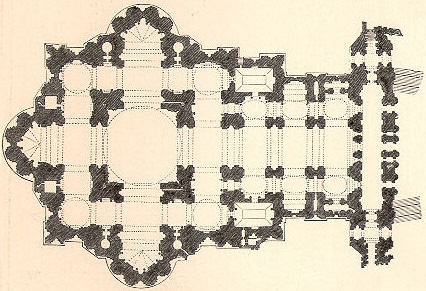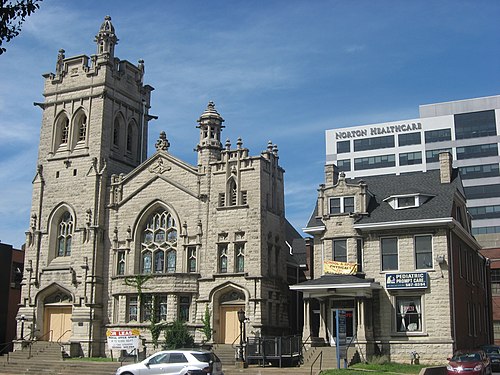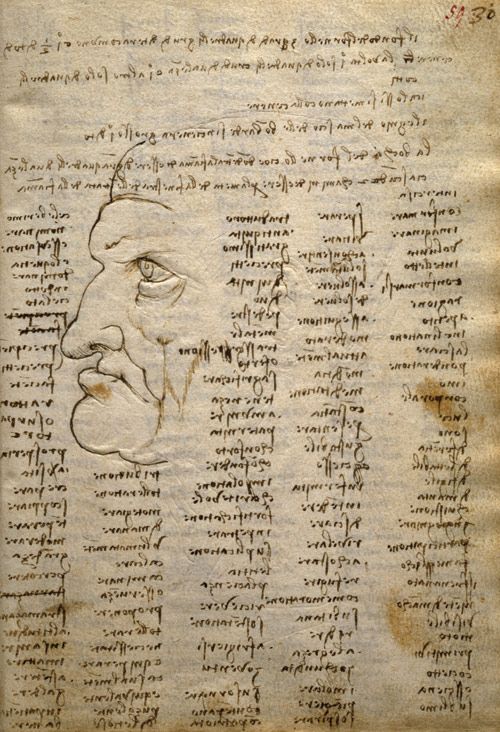Fire Risks and New Threats from Climate Change to Libraries and Archives
The European Environment Agency (EEA) has published in 2012 a document which is “an indicator-based assessment of past and projected climate change and its impacts on ecosystems and society” (the 2016 version of the report is available at this website). According the document, Europe will experience over the next few decades some effects caused by climate change. The expected changes are not uniform throughout the mainland, but they can be summarised in a number of homogeneous areas. Table 1 illustrates the qualitative trends provided in seven climatic regions.
With regard to fire prevention, in addition to the obvious problem of the increased risk caused by the increase in average temperatures, it may be interesting to analyse which might be the effects of these changes on the measures taken to protect the content of libraries and historical and artistic value archives against the risks derived by the new cheater conditions.
Unlike digital archives, in fact, these fire protection features are conditioned by the presence of materials subject to attack from insects and microorganisms. So, the measures taken to limit the damage caused by insects and microorganisms could raise some fire protection issues.
To explain the relationship between the risk of proliferation of dangerous insects for the paper, may be useful to start from the identification of the change expected in Europe. Official publications indicate that diversified mechanism depending on the weather areas will affect each region. In particular, in the European continent seven different mechanisms of change can be identified, but one of the most common aspects appears to be the increase of average temperatures and the simultaneous increase of the rainfall.
The document of the Piemonte region (Italy) on the state of the environment in 2016 [2] which relates to the impact of climate change on cultural heritage, noted that “The main heritage degradation factors are of a physical nature chemical and biological”:

- Temperature (T): day / night variations, seasonal. Thermal stress and the freeze / thaw cycles cause damage to the porous building materials (marble, plaster, bricks …);
- Atmospheric Water: rain precipitation, relative humidity (RH%). Water is the most critical parameter as it acts, either directly or indirectly, in most of the degradation processes both physical and chemical and biological: heavy rains can provoke a mechanical erosion action of the surfaces; the water dissolves and conveys soluble salts within the recrystallizing materials that, as a result of ambient relative humidity variations, cause breakage and damage; high humidity conditions favor the proliferation of biological attacks (mold, bacteria, mosses …);
- Winds: the particles transported by the winds exert mechanical erosion action on the surfaces, they may also be deposited by creating coatings of surface deposit. The winds convey water and soluble salts (marine aerosols carrying sodium chloride) potentially harmful even in areas protected from the direct action of rain;
- Biological growths: both the archaeological sites located in rural areas, and the monuments and buildings in urban areas may be colonized by plants, animals and microorganisms such as bacteria, fungi, algae, lichens. The formation of coatings on surfaces in addition to the strong aesthetic impact induces a constitutive biodeterioration of materials which can lead to partial or total loss of the work itself. Of course, the proliferation of biodeteriorigeni is a phenomenon closely related to climate and environmental factors;
- Atmospheric pollutants: carbon dioxide (CO2), sulfur compounds (SOx), nitrogen oxides (NOx), particulate matter (PM2.5, PM10), ozone (O3) contribute to the degradation of the assets, especially in an urban environment, through different mechanisms of alteration. The pH of rains acid promotes the dissolution of stone materials with carbonate matrix, the sulfur dioxide is the main cause of sulfation processes that lead to the formation of black crusts transforming the calcium carbonate chalk (more soluble and easily washed out by rainwater ) and affecting bronzes (oxidation of the surfaces of the monuments with copper idrossisolfati formation, its characteristic green color); the atmospheric particulate matter is deposited on the surfaces creating unsightly black crusts, coatings and transporting of organic pollutants which are adsorbed and can interact with the constituent materials of the works”.
Given these premises, any design solutions (for archives and libraries) have to be addressed in the light of eco-sustainability, it may be interesting to mention the criteria, that the reference [3] summarises in the following points:
- A highly insulated envelope
- Effective solar shading Which uses natural elements such as trees and roof overhangs as well as by shading louvers run by photovoltaic cells.
- A low rate of natural air infiltration
- An exposed concrete internal construction, Which Retains the heat,
- An efficient low-pressure mechanical ventilation system
- An electrically powered heat pump for heating via the air and thermostically controlled perimeter radiators. During the summer, it cools the building, making Further refrigerating and air conditioning unnecessary.
- Excess energy can be exported to adjacent buildings
- The energy is 100% renewable
- Compact fluorescent lighting, occupancy sensors and sun-shading devices are Also used to improve energy efficiency.
These criteria indicate the need to eliminate the ventilation openings of the storage rooms of libraries (in order to lower outside air infiltration volumes). Some of fire prevention rules recommend permanent ventilation openings in archives, to limit the damages due to combustion products and make it easier extinguishing operations. So, the need to limit damages due to the insects and microorganisms due to the increase of temperature and ambient humidity, brings to eliminate the ventilation permanent openings requested by some fire prevention standards.
Both problems (protection against fire and from attacks of insects and microorganisms) may find an answer in adopting automatic systems. So, the final consideration highligths the criticality of this type of solution, that implies high levels of reliability. Currently, there are no standards dealing with the reliability of the systems governing fire safety of cultural heritage and this lack may be considered a gap to be filled.
[1] Füssel, H.-M., & Jol, A. (2012). Climate change, impacts and vulnerability in Europe 2012. Copenhagen. Retrieved from http://www.eea.europa.eu/publications/climate-impacts-and-vulnerability-2012/at_download/file
[2] Relazione sullo stato dell’ambiente Piemonte 2016. (2016). Retrieved April 17, 2017, from http://relazione.ambiente.piemonte.gov.it/2016/it/clima/impatti/patrimonio-architettonico
[3] Ebunuwele, G. E. (2015). Global Warming : Implication for Library and Information Professionals. International Journal of Humanities and Social Science, 5(6), 69–77.





